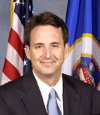Pawlenty Invokes Obama and Displays Fancy Footwork On Tax Policy in Budget Presentation

Such began Round 1 of Pawlenty vs. the DFL.
While the Governor’s budget presentation focused on several other elements that engendered a quick and fierce critique from his loyal opposition (such as a cut in the rate of increase of HHS spending and its likely impact on health care coverage), Pawlenty first raised the tax issue by citing his apparent newfound ally in Washington, D.C., Barack Obama:
“We also think it is important, as does President Obama and most economists, that we not raise taxes when we have this type of economic crisis.
Invoking Obama, who is exceedingly popular in Minnesota and even well-regarded in Republican circles, was a shrewd opening move for the Governor – a stinging punch to any DFLers who would propose ‘revenue raising measures’ to balance the budget deficit this session.
Pawlenty then nimbly tried to negotiate two aspects to his tax policy with competing rhetorical devices.
First, Pawlenty aggressively drummed home his familiar ‘no tax increase’ mantra by stressing how important it is to the lives of Minnesotans that they not incur any more tax burden from the state:
“There is broad consensus in the country that when you have a recession that it is this deep, particular in highly-taxed places like Minnesota, that it is not wise to add to the burden of Minnesota taxpayers and Minnesota families by increasing the bill they receive from government. So we believe it is important to hold the line on taxes and, in fact, in a few cases strategically reduce them.
The “few cases to which Pawlenty refers totals $287 million for the biennium, and led the Governor to display a second tactical maneuver in the political ring – a more defensive posture on tax cuts. Pawlenty tried to diminish the impact such cuts would have on the budget, and therefore preemptively and unilaterally declare them as a non-controversial element to his budget proposal (and thus disarming DFLers who would critique this component).
“As the debate unfolds you’ll inevitably and predictably hear people talk about, “How can we be cutting taxes when we can’t get the budget balanced? … If you focus just on the corporate tax rate deduction which gets most of the attention…that’s only about 147 million for the whole biennium. That’s not even a meaningful variable in the context of the 5 billion dollar deficit or a 34 billion dollar budget. It’s significant, but to suggest that it is the focal point of the debate when the impact of it is 147 million dollars would suggest it is a bit misguided or misleading.
Such is a sampling of the fancy footwork and artful rhetoric Pawlenty displayed on Tuesday – stressing with great conviction the harm tax increases would cause to the state of Minnesota on the one hand, and then cavalierly and defensively proposing tax cuts as if they were inconsequential to the budget process altogether.
Of course, no amount of rhetorical trickery could stave off attacks from DFL leaders, who had their ammunition already locked and loaded and were quick to blast Pawlenty’s corporate tax cut proposal by linking it as the primary explanatory variable as to what would impede the reversal of problems facing working families, those who have lost their jobs, and those with tenuous or no health care coverage.
A Senate DFL talking points memo released Tuesday afternoon stated:
“The Governor’s budget ignores the real problem our state faces: a lack of jobs. He’s giving tax breaks to big business that they’ll use to redecorate their boardrooms instead of creating jobs.
Minnesota DFL Chair Brian Melendez was far less diplomatic in his response:
“Minnesota’s tax system is already unfair; Governor Pawlenty would make it even more unfair with tax breaks to corporations so that they can pay bigger bonuses to their executives and buy nicer artwork for their boardrooms — not create the jobs that Minnesota desperately needs. And while the wealthiest Minnesotans would pay less of their income in taxes, the rest of us will keep paying more and getting even less: less access to health care, less access to higher education and less safety in our homes and on our streets. To ease the burden on middle-class families and focus our spending on economic recovery, we must instead close corporate tax loopholes and end tax breaks for the wealthy. The governor can still change course and put all the options on the table, instead of cherry-picking recommendations that appeal to the Republican base and hurt the middle class…Tim Pawlenty was elected to serve the people of Minnesota, not the Iowa Republican Party, where evidently he is already auditioning for his next gig.
It is unclear whether Melendez threw in that last line of Pawlenty running for president as a cheap political shot, or as wishful thinking in order to increase his party’s chances of taking back the Governor’s mansion for the first election since 1986.
As for Pawlenty, his command of the lectern may well take him several rounds deep into the budget battle. However, facing down 87 DFLers in the House and a veto-proof DFL majority in the Senate, what the Governor may really be fighting for is a split-decision of some sort.
The sound of the ringing bell you hear is the start of Round 2.

Mr. Pawlenty’s budget could be worse. He could have further followed the example of the recently departed from DC and proposed a state funded bailout for starving Minnesota CEOs. A couple hundred million dollars in tax cuts is as close as he can get.